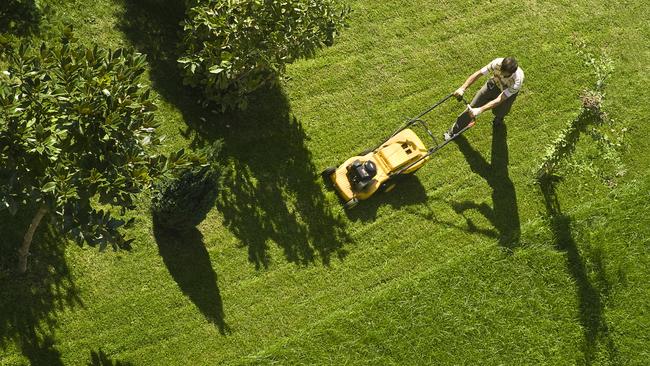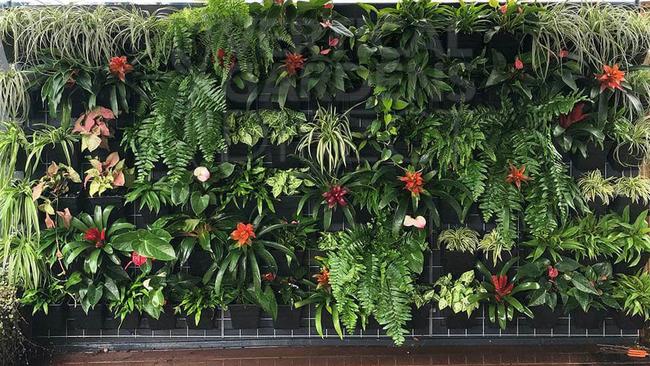Lawn order: how to keep your lawn in shape
Here’s how to keep yours in tip-top shape.

Whether your lawn is a velvety sward or a scruffy mix of green bits depends on your inclination and situation. But lawns sure generate a lot of questions to the Q&A column, so let’s look at the basics.
With spring under way, it’s a good time to repair, renovate or renew your lawn. At the very least, spread some lawn fertiliser, ideally just before a shower of rain can water it in.
A good lawn is a result of regular mowing (not too short), fertilising and watering – but there are some important underlying factors. The soil needs to drain well and not be compacted. Bowling and golf greens can be 90 per cent sand to resist heavy wear and drain rapidly – but this also means frequent watering. Where you have clay soil and heavy foot traffic, it compacts when wet, which impedes drainage, dries hard like concrete and stops the roots growing. To combat this, open up the soil with a garden fork regularly – and for new lawns, install a layer of sandy soil under the turf.
The soil pH also affects growth. Lawns prefer a neutral pH around 7 but many soils are naturally acidic and lawn fertilisers increase acidity over time. Simple pH test kits are available at garden centres. To raise the pH, add lime – either broadcast as a powder and watered in, or as a hose-on product.
For new lawns, long-term success is all about the preparation – a bit like painting. Get rid of weeds, decompact, improve the drainage and correct the pH before adding any new soil; laying the turf rolls is just the final, satisfying part.
Choose a turf type that suits your climate, aspect and purpose. Kikuyu, used on sports fields, is tough and cheap to buy, but grows so quickly you’ll be mowing every week. Both it and couch varieties invade garden beds aggressively. Couch gives that fine texture but needs rigorously frequent mowing (it’s daily on golf courses). With the exception of the Queensland Blue variety, couch is not shade-tolerant and usually browns off in winter. Softleaf buffalo varieties dominate the home lawn market because they tolerate shade and wear and generally stay green in winter. Many people know ‘Sir Walter’ through good marketing but others include ‘Kings Pride’, ‘Sapphire’, ‘Palmetto’ and ‘Matilda’. Other turf types include salt-tolerant ‘Nara’, bred from the Australian grass Zoysia macrantha, and a newer entrant, ‘Sir Grange’, a zoysia lawn with a fine texture and a high tolerance for drought and wear.
These are all warm climate grasses that spread by runners and grow when the soil is warm. They’re only available as cut turf rolls, not seed, because they must be reproduced from runners. In cold climates, cool season grasses such as fescue, rye and bent can be used as they survive frosts.
A strong lawn outcompetes most weeds, so weeds indicate an imbalance. Clover flourishes when there’s a lack of nitrogen, so fertilising is the first strategy to combat it. Like other large weeds, you can remove clover by hand using an old knife or weeding tool, or spray carefully with an organic weed spray, being careful not to get it on the lawn itself. Selective lawn herbicides are available, too, but follow the label directions carefully. “Weed and feed” products do neither very well, and why put herbicide on healthy areas of lawn?
Good to know
A touring exhibition, The Blade, traces the story of lawn in Australia. Curated by the Australian Museum of Gardening at Carrick Hill, SA as part of the Australian Garden History Society’s 40th anniversary, it’s due at the Canberra Museum and Gallery (cmag.com.au) from November 20, and next year at New England Regional Art Museum, Armidale (neram.com.au) The Lawn: A Social History (Pier 9) is a fascinating book by Australian science writer and broadcaster Peter Macinnis. The Victa mower was developed in Sydney by Mervyn Victor Richardson in 1952. (To see Victa’s latest model, go to Road Test on page 42.)
Q&A
Can onion skins and citrus peels be composted? I’ve heard differing opinions. And are crushed eggshells good for soil? Sue Dornan, Sydney
You can compost anything that comes from a plant. Avoid weed seeds and bulbs, and too much of any one thing at a time. Good compost is about getting the right balance of green/nitrogen-rich/wet materials and brown/carbon-rich/dry ingredients, with the right moisture level. Aeration speeds the process. Citrus skins compost well, but are faster when cut up. Eggshells are high in calcium; crushing them makes them decompose faster.
Is now a good time to plant my Davidson plum tree in the garden? It has grown from tubestock to about 25cm tall. Isabell Bloemer, Brisbane
Unlike transplanting, planting from pots is less time critical because, with care, this puts little stress on the root system. However, ideally you want plants established before the heat of summer, so don’t delay. Autumn and spring are great times to plant in most regions of Australia – and in your warm climate, winter would be fine too.
How hard should I prune my flowering cherry trees? There’s some dead wood in them and they’re not flowering as well as usual. Lyndel Holt, Melbourne
Ornamental cherries need little pruning except to remove dead wood and crossed branches, and to lightly maintain the tree’s shape. The best time is after flowering. Remove any suckers below the graft any time they appear. Poor flowering can be due to too much shade, warmer winters or poor tree health. Keep the roots cool with mulch, apply organic fertiliser and keep watered in summer.

Send your questions to: helenyoungtwig@gmail.com or Helen Young, PO Box 3098, Willoughby North, NSW 2068. Website: helenyoung.com.au. The best question for October wins Wallgarden’s Multi-hang Vertical Garden Kit with 20 modules, worth $138. September’s winner is Kate Brooking of Adelaide for her question about using honey.




To join the conversation, please log in. Don't have an account? Register
Join the conversation, you are commenting as Logout